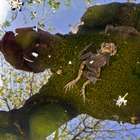Memory Practice #2
Posted June 17, 2020 by Theun KarelseLynne Kelly wrote two books on how pre-literate cultures stored information. I've been interested in early hominids in Europe for a long time. It seemed impossible that we'd ever gain any insight in the lives of those people.
The few material remnants left behind seem reluctant witnesses to the past. But Lynne's work is the first time that I really feel a door has been opened that gives a deeper insight into those societies.
Much of what may be labeled as 'religious' artefacts in prehistoric collections appears in a very different light to folks who use memory techniques that use features and patterns in landscape or textures as 'hooks' to which narratives are anchored.
I started looking for 'hooks' in my street. A rough and extremely stripped-down analogue of an Aboriginal Songline. See first blogpost. I've been trying to build up a history walk, based on Lynne's outline. But I keep struggling with things that are very repetitive, like dates.
Yes the dinosaurs emerged at the drunkenman's house next to the hatshop, and met their demise at the cafe near the traffic light. But the numbers: was it 235 millions years or 154 million? No thats Cretaceous at 145 million years..
I imagine 2 dinosaurs playing darts, three playing pool and 5 playing poker as an image to remember the date. Somehow this still defies the point. To really utilise the memory-machine in my head it needs to be embedded in story.
And more importantly, I find that actually every 'data-point' needs a story! So now I ended up trying to remember random stories, next to the kebabshop, the hairsalon, the tatooshop from which different early hominids are emerging. In a break through moment I realised that a Songline is embedded in a meta-narrative: I needed an overarching mythological framework.
At this level I find that myth is the juice that makes these practices run. It startes working when I populated the world with 'gods': beings that shaped the world. One of them is in the photograph above, a surinamese man, one of those characters that everybody in the neighbourhood knows, who hangs around with shopping trollies full of trash and addresses passers-by singing the title-line from the 2unlimited pop single at them: "I like to move it, move it".
This somehow seemed very appropriate for a being that builds universes. In addition, this neighbourhood's mythological world is populated by an ever growing crowd of comic book and film characters, famous people, famous animals, giant fruit, and ancient disasters.
Adding myth to your neighbourhood is pretty inspiring, and in a strange way it starts to infiltrate all layers of life, which is fun. But it does dawn on me that this practice makes way more sense if its practiced by more than 1 person. So maybe it's time to expand it..
Created: 15 Jul 2021 / Updated: 23 Oct 2021



